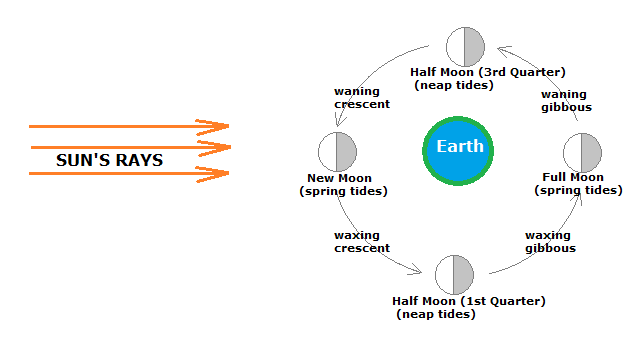- Earth's MOON:
The Moon circles the Earth approximately every 28 days.
One period of the Moon's revolution around the Earth is called a lunar month.
(The word "month" was originally pronounced "moonth".)
The Moon has no light of its own. When we see the sun-lit half of the moon, we call it a "full moon".
When we see less than half of the sun-lit half of the moon, it is shaped like a crescent, and we call it a "crescent moon".
When we see half of the sun-lit half of the moon, we call it a "half moon" (really a quarter-moon).
When we see more than half of the sun-lit half of the moon, we call it a "gibbous moon".
If the lit-up part of the moon is increasing from day to day, it is said to be "waxing". (The verb 'to wax' means to increase or get bigger.)
When the Moon is waxing, the illuminated part is always on the right as seen from Earth.
If the lit-up part of the moon is decreasing, it is said to be "waning". (The verb 'to wane' means to decrease or get smaller.)
When the Moon is waning, the illuminated part is always on the left.
The surface of the Moon has many craters. It also has large flat areas called maria (the singular is mare).
- Tides:
Daily tides:
The Moon's gravity pulls on the ocean waters of Earth and creates a bulge of high water (high tide) on the side facing the moon.
There is also a bulge on the side facing away from the moon because the moon's gravity is pulling the Earth away from its ocean waters on that side.
In between, but especially at places on the Earth's surface 90o away (in any direction) from where the moon is overhead, the ocean surface
is least affected by the moon's gravity, and those places experience low tide.
Earth's rotation causes the 'high tide' bulges to move around the planet (or to remain facing toward and away from the moon as the planet rotates
beneath them), so every point on the Earth's surface experiences high tides twice a day (and low tides in between).
Monthly tides:
When the Sun, Earth, and Moon are all in a straight line, the effects of the Moon's gravity are strongest because the gravitational pull of the sun adds to them.
For this reason, we experience the "Spring tides", meaning the highest high tides and the lowest low tides, twice a lunar month.
When the Sun, Earth, and Moon form a 90o angle (or when the Sun's position and the Moon's position in the sky are 90o apart), the effects of the Moon's
gravity are weakest, and we experience "Neap tides", meaning the
least extreme tides (the lowest high tides and the highest low tides).
Click here for a really good graphic showing the monthly tides.
- Trivia:
An ancient Scandinavian custom.
When a couple got married, people would celebrate the wedding for an entire month.
During this month, they would drink a lot of meade, a type of wine made from honey.
This month-long celebration, featuring honey-wine, was called a honeymoon!

|